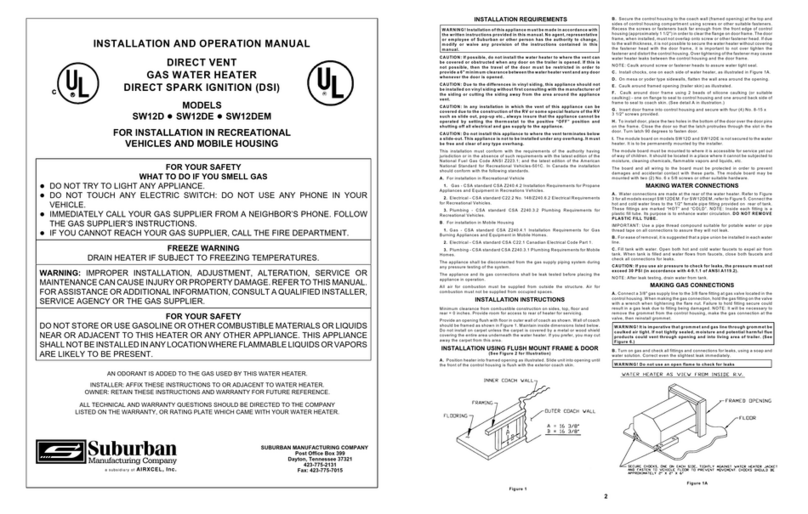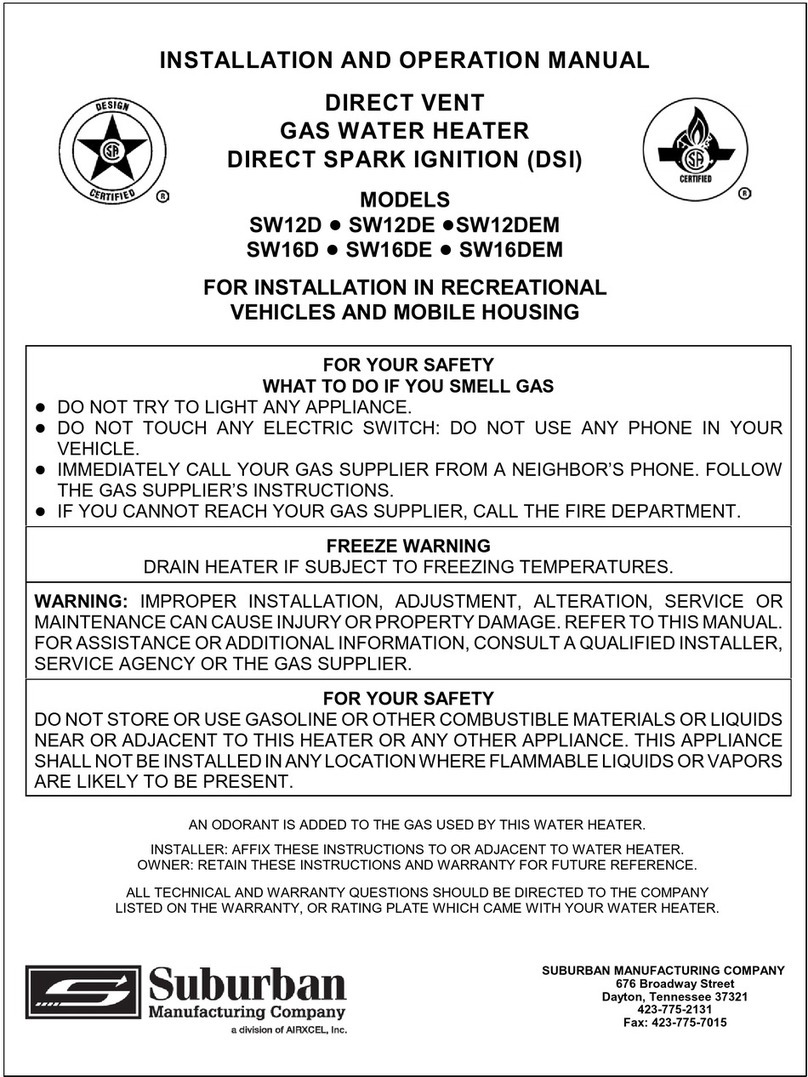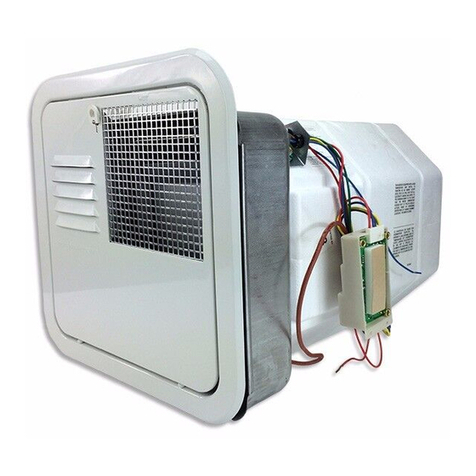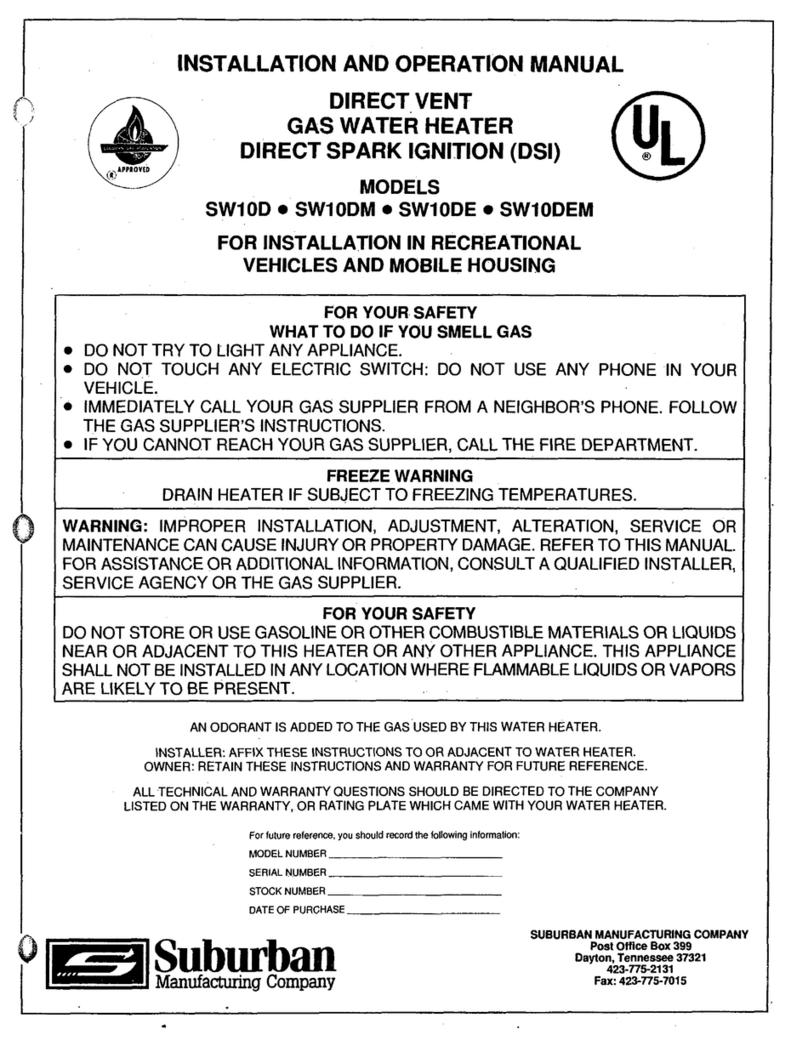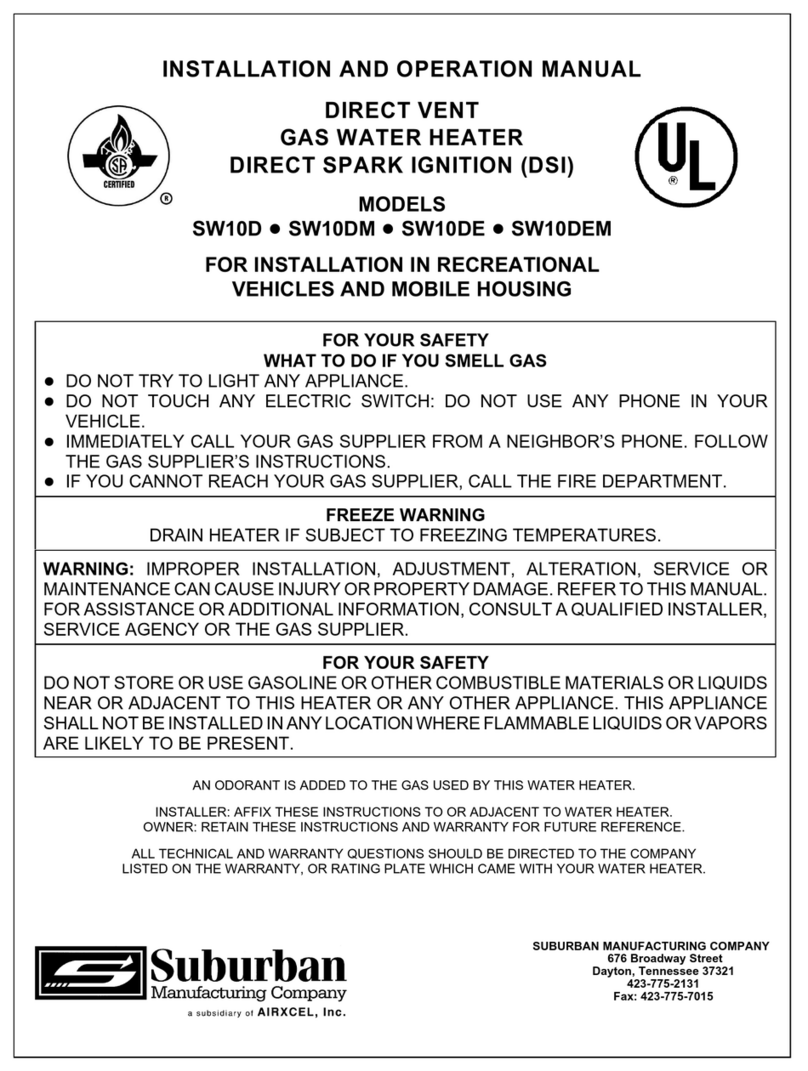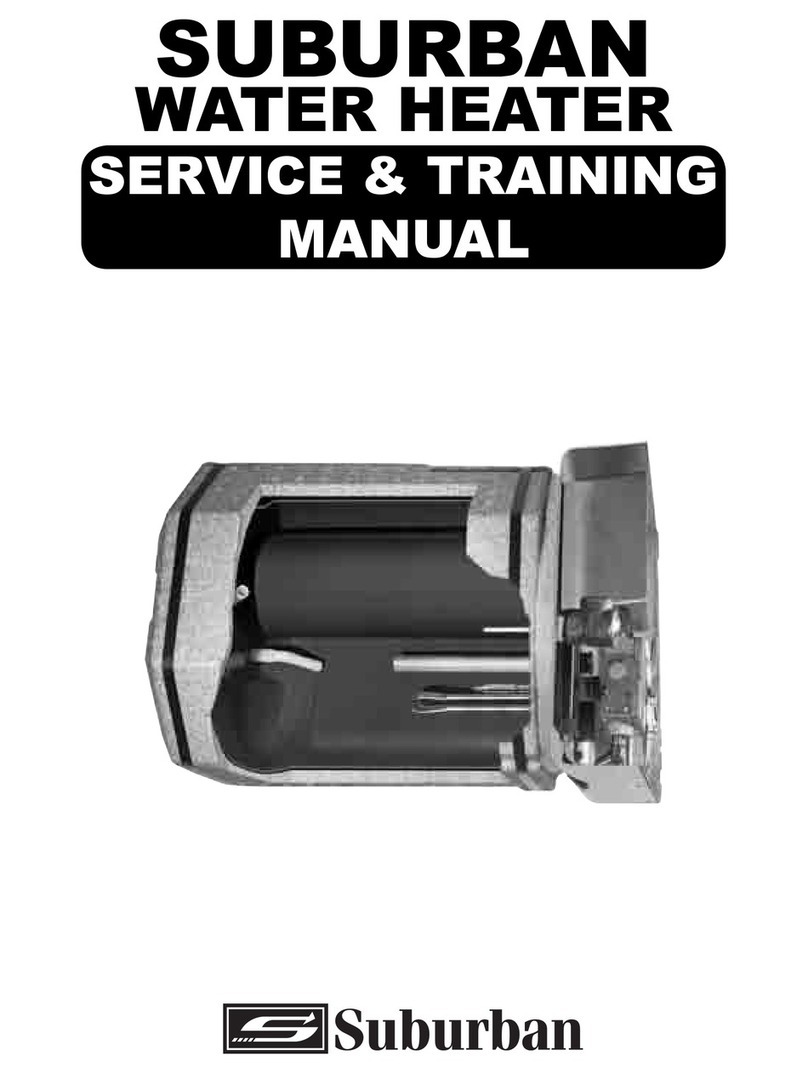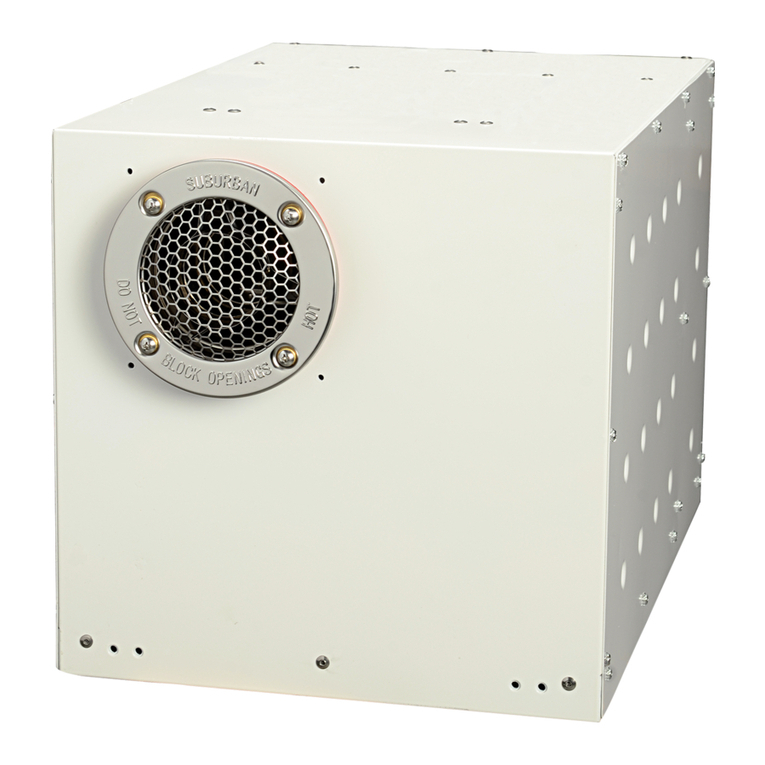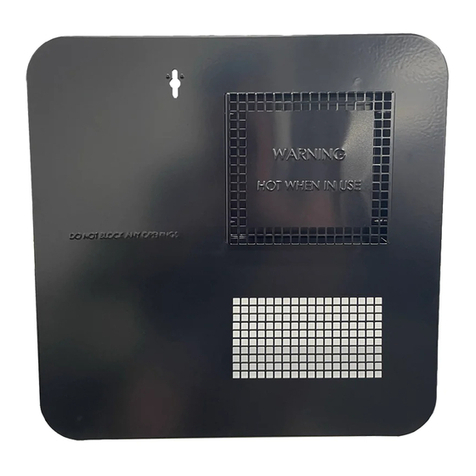
6
Figure 10
Figure 11
WARNING! The thermostat/gas control on your water heater is a
temperature limiting valve. It has been set at the factory to 120°F (49°C)
(on setting) to reduce the risk of scald injury. The thermostat can be
adjusted to a higher setting; however, remember that the water
tem peratures over 125°F (52°C) can cause severe burns instantly or death
from scalds. To change to medium setting (130°F/54°C) or high setting
(140°F/60°C), see operating and lighting instructions.
ANODE PROTECTION
The tank in this water heater is protected by a magnesium or aluminum anode
to prolong the life of the tank by absorbing the corrosive action of hot water.
Under normal use, the anode rod will deteriorate and because of this, we
recommend it be replaced yearly. NOTE: W ater with high levels of iron and/or
sulfate will increase the rate of deterioration; therefore, more frequent
replacement may be required. If anode rod is mostly eaten away, replace it with
a new one. (See Figure 10)
To prevent a water leak when replacing the anode rod, a pipe thread sealant
approved for potable water (such as Teflon tape) mustbe applied to the threads
of the anode rod. Proper application of a thread sealant will not interfere with
the anode’s tank protection.
Operating the water heater without proper anode protection will decrease tank
life and will void your warranty on the tank. NOTE: Tank is drained by removing
anode rod (See “Drain and Storage” instructions).
To extend anode life, drain water from tank whenever RV is not being used.
Avoid any extended time of non-use with water in tank. Also refer to the section
on winterizing.
WARNING! Do not replace the anode rod with any non-Suburban
accessory part, such as an “add-on” electric heating element. Items such
as these are not approved to be installed in Suburban products. They
could create an unsafe condition and will also void all warranties.
PRESSURE RELIEF VALVE
The temperature and pressure relief valve is designed to open if the temperature
of the water within the heater reaches 210°F, or if the water pressure in the heater
reaches 150 pounds. Recreational vehicle water systems are closed systems and
during the water heating cycle the pressure build-up in the water system will reach
150 pounds. When this pressure is reached, the pressure relief valve will open
and water will drip from the valve. This dripping will continue until the pressure is
reduced to below 150 pounds, and the valve closes. This condition is normal and
does not indicate a defective relief valve.
WARNING! Do not place a valve between the relief valve and the tank. Do
not plug the relief valve under any circumstances.
WATER WEEPING OR DRIPPING FROM PRESSURE
RELIEF VALVE
You may experience water weeping or dripping from your water heater’s Pressure
and Temperature (P & T) Relief Valve when your water heater is operating. W ater
weeping or dripping from the P & T Valve does not always mean the P & T Valve
is defective. As water is heated, it expands. The water system in a recreational
vehicle is a closed system and does not allow for the expansion of heated water.
When the pressure of the water system exceeds the relieving point of the P & T
Valve, the valve will relieve the excess pressure.
Suburban recom mends that a check valve not be installed directly at the inlet to
the water heater tank. This will increase weeping of the pressure relief valve.
WARNING! Do not remove or plug the relief valve.
One way to reduce the frequency of this occurrence is to maintain an air pocket
at the top of the water heater tank. This air pocket will form in the tank by design.
However, it will be reduced over time by the everyday use of your water heater.
To replenish this air pocket:
1. Turn off water heater.
2. Turn off cold water supply line.
3. Open a faucet in the RV.
4. Pull out on the handle of the Pressure Relief (P & T) Valve and allow water
to flow from the valve until it stops.
5. Release handle on P & T Valve - it should snap closed.
6. Close faucet and turn on cold water supply; as the tank fills, the air pocket
will develop.
Repeat this procedure as often as needed to reduce the frequency of the weeping
of the P & T Valve. If the weeping persists after following this procedure, you may
elect to install an expansion or accumulator tank in the cold water line between the
tank and check valve to relieve the pressure caused by thermal expansion.
Contact your local dealer for assistance.
THERMOSTAT AND MANUAL RESET
MODELS SW6PE and SW6PER (See Figure 11)
The model water heaters listed above are equipped with a high temperature limit
as a cut-off device. Temperature above 180°F will cause m anual reset button to
trip shutting down the electric element.
To activate element, the water temperature must be below 110°F, push reset
button to re-activate the electric element.
DRAINING AND STORAGE INSTRUCTIONS
If RV is to be stored during winter months, the water heater must be drained to
prevent damage from freezing.
1. Turn off electrical power to water heater either at the switch from the electrical
element or at breaker.
2. Shut off gas supply to water heater.
3. Turn off pressure pump on water system.
4. Open both hot and cold water faucets.
5. Remove anode rod from tank.
6. Follow RV manufacturer’s instructions for draining entire water system.
NOTE: Be certain to refill water heater with water and remove all air from tank and
lines before re-lighting or before turning on electrical power.
ODOR FROM HOT WATER SYSTEM
Odor from the hot water system is not a service problem and many water supplies
contain sufficient amounts of sulphur to produce an odor. The odor is similar to
rotten eggs and is often referred to as “sulphur water”. It is not harm ful - only
unpleasant to smell. Sulphur water can be caused by a chemical action or by
bacteria. The solution to eliminate is chlorination of the water system. Add about
six (6) ounces of chlorinated common household liquid bleach to each 10 gallons
in the water tank. Then run the chlorinated water throughout the system, opening
each faucet one at a time until you sm ell the chlorine. Let the RV sit for a few days
and the chlorine should take care of the problem. Then you will need to take care
of the chlorine. Rem ove the chlorine by flushing the system with fresh water. This
may take several attempts. You may consider adding a filtering system that
removes chlorine and prevents sulphur water. If the sulphur or rotten egg smell
continues, flush the system once again as described above and replace anode rod
as necessary.
REMOVING WATER HEATER
1. Shut off gas supply and disconnect gas supply line from water heater.
2. On all Electric Models, disconnect 120 V.A.C. supply at junction box mounted
on heater.
3. Shut off water supply. Drain water from tank following instructions under
“Draining and Storage”.
4. Disconnect hot and cold water lines from water heater.
5. Remove screws or nails securing control housing to framed opening.
6. Slide heater out. To reinstall, follow instructions in manual under “Installation
Instructions”.
WINTERIZING
If your water heater plumbing system is equipped with a bypass kit, use it to close
off the water heater, drain the water heater completely and leave the water heater
closed off (out of the system) in the bypass position particularly if you are
introducing antifreeze into the plumbing system. Antifreeze can be very corrosive
to the anode rod creating premature failure and heavy sediment in the tank. If the
plumbing system is not equipped with a bypass kit, and you intend to winterize by
adding antifreeze to the system, remove the anode rod (storing it for the winter)
and replace it with a 3/4" drain plug.



